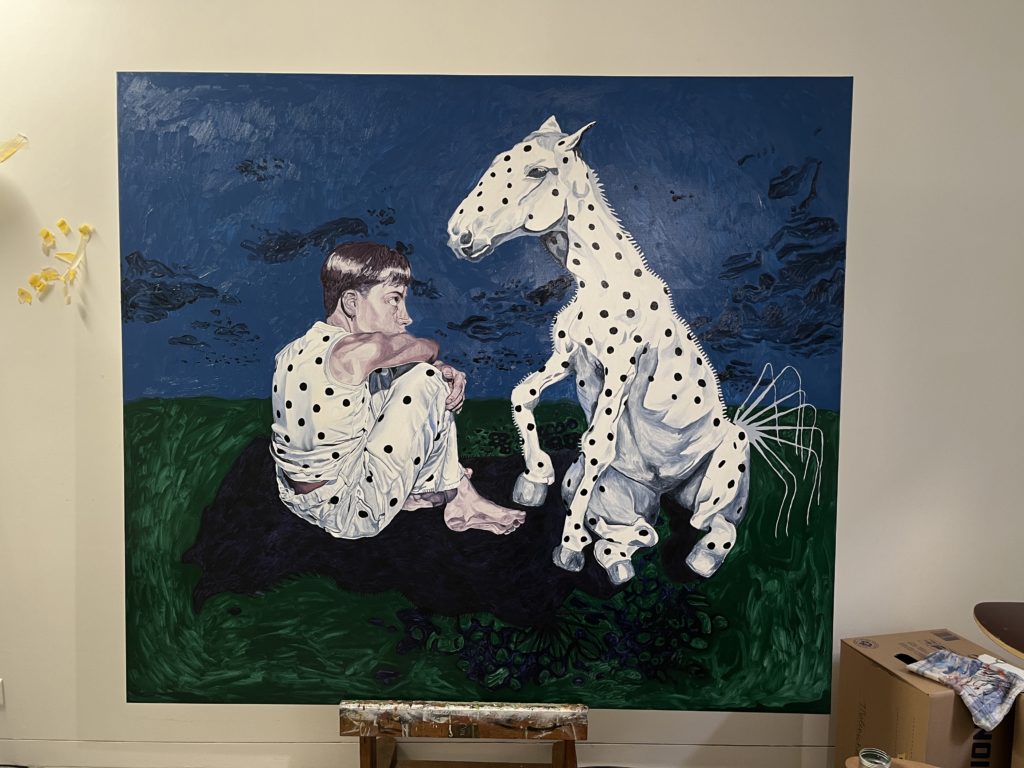
RÉSIDENCE INTERNATIONALE 2024 ROBIN VAN LEIJSEN : Projet de résidence
C’est lors d’un voyage en Espagne l’été dernier que Robin van Leijsen croise pour la première fois un cheval tacheté, un animal qui dès lors commence à l’obséder. À son arrivée à la Cité des arts, l’artiste sait qu’il lui faut intégrer ce sujet dans son projet de résidence. Depuis presque deux mois, iel explore ainsi son obsession pour l’animal, devenu source de fascination malgré la peur qu’il lui inspire.
Comme pour chaque projet, Robin débute avec une grande carte mentale, réalisée à partir de différentes images collectées en ligne, sur Pinterest.
C’est alors qu’iel commence lentement à percevoir des liens entre le cheval et le thème de l’amitié qu’iel souhaitait explorait à l’origine pendant cette résidence. Comme l’indique l’artiste, iel a toujours eu très peur des chevaux, leur taille et leur profonde sensibilité les rendent à la fois très effrayants et fascinants. À travers ses productions, iel explore comment iel fait du cheval (sa peur), son ami.
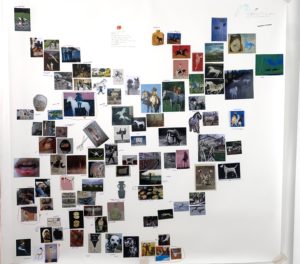
Toujours avec humour et une touche d’absurde, iel commence alors à explorer sa relation complexe avec l’animal au moyen de la peinture, du dessin, de l’aquarelle, du collage et de la vidéo.
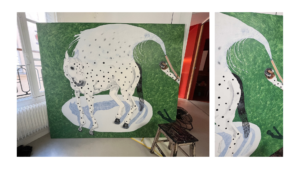
Après une première toile figurant la forme même du cheval, une seconde peinture, en cours de production, pose un regard sur la relation de l’artiste à l’animal, à travers un face à face entre l’artiste, représenté·e les habits tachetés de points noirs, assis·e sur le sol, fixant le cheval tacheté, assis face à iel. Cette toile met l’accent sur la réaction épidermique que provoque cette rencontre : la chair de poule, titre français donné à la toile par l’artiste, pour tous les sens que renferme l’expression.
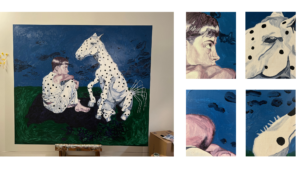
Dans ses autoportraits dessinés, l’artiste en vient à incarner sa propre peur, se transformant progressivement en animal. Si l’artiste conserve son style très réaliste, notamment dans les autoportraits, iel se détache progressivement de la précision, pour induire du mouvement, un dessin plus libre. À cela s’ajoutent des aquarelles, une technique qu’iel utilisait peu jusqu’alors, lui permettant d’expérimenter autrement encore le sujet.
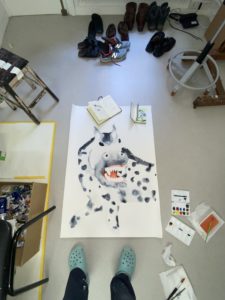
*
During a trip to Spain this summer, Robin van Leijsen came across a spotted horse on their way, an animal that began to obsess them. On their arrival at the Cité des arts, the artist knew they had to incorporate this subject into their residency project. For almost two months, they have been exploring their obsession with the animal, which has become a source of fascination despite the fear it inspires.
As in every project, the artist begins with a large mental map, made from various images collected online on Pinterest. It was then that they slowly began to perceive links between the horse and the theme of friendship that they originally wanted to explore during this residency. As the artist points out, they have always been very afraid of horses, their size and deep sensitivity making them both very frightening and fascinating. Through their productions, Robin explores how to make the horse (their fear), their friend.
Since their arrival, the artist has explored this complex relationship with the animal through painting, drawing, watercolor and video. Their first painting shows a spotted horse forming from a water. Here we find the artist’s signature touch of absurdity and sometimes humor.
A second canvas takes a look at the artist’s relationship with the animal, through a face-to-face encounter between the artist, depicted with their clothes spotted with black dots, seated on the ground, staring at the spotted horse, seated opposite them. This painting, still in production, emphasizes the epidermal reaction provoked by this encounter: la chair de poule (goose bumps), the French title given to the painting by the artist, for all its various connotations.
In their drawn self-portraits, the artist comes to embody their own fear, gradually transforming themself into an animal. While the artist retains their highly realistic style, particularly in the self-portraits, they gradually detaches themself from precision, to induce movement and free-flowing drawing. To this are added watercolors, a technique they rarely used before, allowing them to experiment with the subject in yet another way.


 Faire un don
Faire un don
 Artistes
Artistes
 Mon profil
Mon profil

